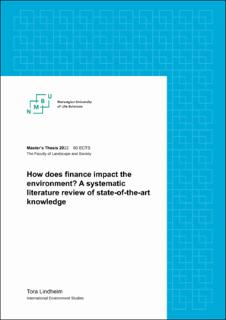| dc.contributor.advisor | Gomez Baggethun, Erik Nicolas | |
| dc.contributor.author | Lindheim, Tora | |
| dc.date.accessioned | 2022-12-08T09:02:00Z | |
| dc.date.available | 2022-12-08T09:02:00Z | |
| dc.date.issued | 2022 | |
| dc.identifier.uri | https://hdl.handle.net/11250/3036657 | |
| dc.description.abstract | Financial systems have been expanding globally for many years, while their negative impact on the environment is becoming increasingly evident. Meanwhile, prevailing frameworks to examine the relationship between finance and the environment fail to account for risks financial systems pose to the environment (finance-to-environment risks). Therefore, financial institutions and markets, in turn, fail to account for finance-to-environment risks despite aims to do so. Thus, an enhanced understanding of these risks is crucial to improving environmental quality. This thesis investigates what is known about the finance-to-environment risks by conducting a systematic literature review on the environmental impacts of financial systems. The findings indicate that financial systems pose environmental risks through two main groups of mechanisms. First, financial systems pose risks to the environment through their functions to the overall economies and the improvement or worsening in performing these functions. Second, financial systems also pose risks to the environment through (a) economic growth, (b) foreign direct investment inflows, (c) technological innovation, and (d) energy consumption. While these mechanisms represent opportunities to alleviate environmental harm, most prevailing global trends of these mechanisms are to exacerbate environmental harm. This article uncovers knowledge gaps in the finance-to-environment literature and proposes three criteria to bridge these knowledge gaps: future research should (1) incorporate the multidimensionality of financial systems, (2) include aspects of inflows from and outflows to the biosphere, and (3) discuss both options of financial system reconfiguration and transformation. Bridging these knowledge gaps will help future research develop sound policy recommendations for enhanced environmental quality. | en_US |
| dc.language.iso | eng | en_US |
| dc.publisher | Norwegian University of Life Sciences, Ås | en_US |
| dc.rights | Attribution-NonCommercial-NoDerivatives 4.0 Internasjonal | * |
| dc.rights.uri | http://creativecommons.org/licenses/by-nc-nd/4.0/deed.no | * |
| dc.subject | financial systems | en_US |
| dc.subject | finance | en_US |
| dc.subject | environment | en_US |
| dc.subject | ecological macroeconomics | en_US |
| dc.subject | systematic review | en_US |
| dc.subject | environmental degradation | en_US |
| dc.title | How does finance impact the environment? : a systematic literature review of state-of-the-art knowledge | en_US |
| dc.type | Master thesis | en_US |
| dc.description.localcode | M-IES | en_US |

